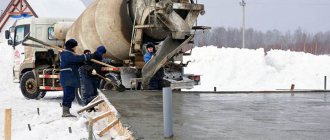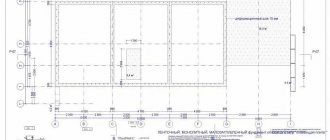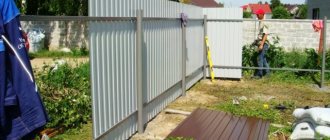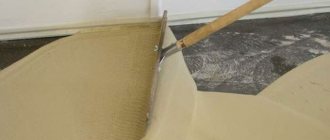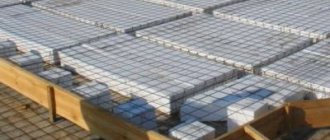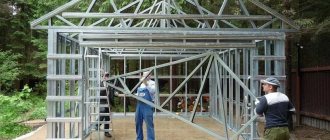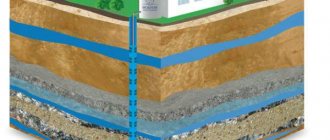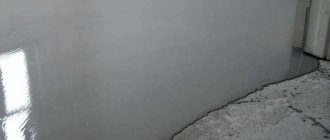Home |Construction |Is it possible to pour a foundation in winter?
Date: November 14, 2017
Comments: 0
In the age of new technologies and high speeds, everything is developing very rapidly. Technical solutions are emerging that allow work to be done faster, better and more efficiently than a couple of decades ago. The construction industry also boasts many innovations that have significantly increased the speed of construction projects. If earlier, for example, when asked whether it is possible to pour the foundation in winter, the developer would have heard a clear “no,” today the answer will not be so categorical. Let's figure out how to carry out this work without loss of quality.
Pouring concrete in winter - some nuances
The question of constructing the foundation of the structure in winter divided the builders into two diametrically opposed camps. The first - adherents of classical technology - believe that no innovations can provide high-quality hydration of the solution. Without it, the strength characteristics of the base may be reduced. The second, supporters of various know-how, argue that it is possible to fill the foundation in winter, providing the required foundation parameters.
Both views on resolving this issue have the right to life. Traditional foundation pouring at above-zero temperatures is described in detail in many sources. Let's try to figure out how to carry out work during the cold season. At subzero temperatures, the water in the solution begins to crystallize, which ultimately leads to an increase in the porosity of the concrete mass. The main problem when pouring the base in winter is ensuring high-quality hydration of the concrete solution.
Not so long ago, with the onset of frosts, it was customary to “freeze” construction in our latitudes.
Reviews
I decided to build a greenhouse on my site for growing flowers. I really wanted my building to be ready for spring. While I was gathering equipment and building materials, clearing a place for construction, autumn came and I practically had no time left for construction. I read about the pile method of constructing a foundation in winter. I decided to try it, despite dissuading friends. The result was excellent. In the spring I was already working in my new greenhouse. Pavel, Rostov-on-Don
I live in a region where spring is prolonged and cold weather comes very early. Moreover, the nature of the soil is not particularly conducive to construction and requires a special approach. A neighbor advised building a foundation when frost sets in and the ground freezes significantly deep enough. That's what I did. Of course, it took a lot of time and effort to dig the trench. And heating the foundation is very expensive. But when I calculated the result, I realized that I had not made a mistake in this matter, but only won. In early spring I continued building my house, which I plan to finish by fall. Sergey, Naryan-Mar
I had an argument with friends about building a foundation in the cold. Just when the opportunity came to prove that I was right, I started building a bathhouse. All work on the construction of the foundation was carried out in winter when it was frosty. I used the technology as written. Heating, canopy, thermal insulation - I used everything. The bathhouse has been standing for two years now and has not shown a single shrinkage or crack. It turned out that it was more profitable for me to build the foundation in winter. Nikolay, Nizhny Novgorod.
Let's look at Mario Rioli's doors: reviews, photos of collections. This article will help you find out about prices for polymer self-leveling floors and their types.
You can learn more about installing interior doors yourself here.
Hydration - educational program for novice builders
The solidification process at above-zero temperatures occurs in stages:
- a thin shell of acidic salt forms on the surface;
- in the upper layers, cement particles are bound with water;
- the outer layer, losing moisture due to evaporation, slowly contracts;
- the cement is bound by water at the next level.
The process gradually covers all layers. Within a month, the concrete gains the necessary strength, sufficient for the next stages of work.
When pouring a foundation in winter, it is difficult to evaporate moisture, which gradually freezes. This leads to an increase in the porosity of the concrete mass and a significant decrease in its strength. Therefore, the main rule for concreting in winter is to ensure normal temperature conditions that prevent the formation of ice crystals during hardening.
Use of additives
When using them, certain factors are taken into account:
- additives that are resistant to low temperatures reduce the need for water required for preparing the concrete mixture by ten to fifteen percent;
- the minimum temperature regime allowing the use of such additives is twenty-five degrees below zero;
- it is prohibited to use modifiers if the air humidity level exceeds sixty percent;
- take into account the fact that certain types of additives can react with metal;
- By adding additives, you do not eliminate the need for additional measures.
Pouring the foundation in winter - technological features
To reduce hardening time, several methods are used that are aimed at maintaining the temperature of the concrete mass within limits that ensure normal hydration conditions.
The length of winter breaks in construction forced residents of the northern country to look for methods that would allow them to continue concrete work in the cold
Heat is retained using:
- pair;
- electricity;
- infrared or induction radiation;
- thermal tent;
- thermal insulation around the formwork.
Let's look briefly at each of the methods.
Heating with steam
Heating the concrete mass with steam significantly accelerates hardening. By maintaining the temperature within 70 degrees Celsius for 1–1.5 days, the concrete reaches a strength corresponding to the solidification of the mass for 15 days at above-zero temperatures.
The duration of steam heating depends on:
- required strength;
- type of cement used;
- warm-up temperature.
Steam heating is carried out by arranging a steam jacket, which is mounted at a distance of no more than 15 cm from the formwork. This parameter ensures free steam flow around the array.
Owners, puzzled by the problem of whether it is possible to fill the foundation in winter, receive a clear affirmative answer, but with many variations
Heating by electric carriers
It is possible to create favorable conditions for concrete hardening using electrical energy. The most common heating methods are:
- electrodes;
- PNSV wires.
Heating with electrodes is a fairly cheap method. Various types of electrodes are used for work:
- strings The main area of application is pouring vertical structures (pillars, columns, beams);
- rod-shaped To maintain the required temperature, metal fittings with a diameter of 8–12 mm are used;
- lamellar. When using plates, they are placed on opposite planes of the formwork.
A more effective way of warming up is to use a PNSV wire. The high efficiency is explained by the fact that the heat source is not the concrete mass, but the wire itself, the temperature of which is much easier to regulate.
A type of electrical treatment of a concrete mass is the effect of infrared or induction radiation on it. Due to the complexity and uneven heating of large volumes, these methods are rarely used.
The electrodes are connected to the transformer at one end, and to the fittings at the other end in increments of about half a meter
Arrangement of a thermal tent
This method is difficult to classify as economically justified. The feasibility of its use can only be determined at sites where there is no possibility of supplying electricity or in regions with frozen soil. The tent is made of polyethylene or tarpaulin. Heat is supplied inside by special self-powered cannons, portable stoves, and, if there is electricity, by any powerful electrical equipment.
Warming up the formwork
Another way to maintain the required temperature is to create an insulating sheathing around the formwork with a steam, electric or water circuit that transfers heat to the concrete mass. The disadvantages of the method include the possibility of uneven drying, leading to cracking of the foundation during operation.
Concreting technology in winter conditions
As part of the work project, activities are developed that ensure:
- Preventing concrete mortar from freezing during transportation, laying and compaction.
- Prevention of freezing of freshly laid concrete until critical strength is achieved.
- Favorable heat and humidity conditions for strengthening of hardening concrete.
Preparation of concrete in winter. Measures to prevent freezing of ready-mixed concrete during transportation, placement and compaction
The finished concrete mixture supplied to the construction site must have a temperature of at least 5°C. To do this, mixing is carried out in warm (up to 70°C) water, and the filling materials are heated.
The cement is not heated to avoid welding. The transportation time of the finished concrete solution should not exceed 4 hours.
Surfaces for concreting and reinforcement must be heated close to the temperature of the concrete solution, for which warm or hot air is used, but not steam or water.
When transporting the finished concrete mixture for a long time and it is impossible to use heating, antifreeze additives are used.
Measures to prevent freezing of concrete before reaching critical strength
There are two main methods of winter concreting:
- warm concrete;
- cold concrete.
Cold concrete is concrete that will harden without heating. To ensure its hardening, special antifreeze additives are designed to reduce the freezing point of water and at the same time accelerate hydration reactions so that the amount of unbound water in the solution decreases as quickly as possible.
Widespread antifreeze additives are electrolytes, Na and K salts, but their use has some limitations:
- sodium salts are not used in reinforced concrete, as they lead to corrosion of the reinforcement;
- some types of Portland cement (for example, highly alkaline or made from clinker with a high content of aluminosilicates) are not used in conjunction with electrolytes;
- sodium and potassium salts are not used in mixtures with potentially reactive rock filler;
- electrolyte salts should be tested experimentally for the formation of efflorescence.
Modern complex antifreeze additives do not have the disadvantages of electrolyte salts, provide the ability to carry out concrete work at low temperatures and have a complex effect (not only antifreeze, but also plasticizing and others).
Warm concrete is concrete that, after laying, is subjected to various heating and heating procedures.
Methods for heating concrete
After the concrete is laid and compacted, it is necessary to maintain an optimal temperature until critical strength is achieved, for which three types of measures are used:
- thermos method;
- construction of greenhouses;
- heating the concrete.
These measures are used both independently and in combination with antifreeze additives.
The choice of method depends on many factors:
- type of construction;
- composition of the concrete mixture;
- presence and type of fittings;
- presence or absence of appropriate equipment;
- economic expediency.
Heat conservation or "thermos method"
The thermos method is used in massive structures alone or in combination with accelerator additives. Accelerators contribute to faster hardening of concrete, which means that critical strength will be gained faster.
The hydration reaction is exothermic, that is, it occurs with the release of heat.
In massive structures, enough heat is released for heating, therefore, if you pour concrete into insulated formwork, and after pouring, cover it with PVC film and heat-insulating materials (mats, rolled materials, boards, foam), the concrete will maintain a temperature suitable for hardening up to a critical temperature strength.
- energy saving;
- using concrete's own heat;
- relative simplicity.
Disadvantages of the thermos method:
- use only in massive structures;
- ineffectiveness at particularly low temperatures (solved by adding antifreeze additives);
- not suitable for designs with a large cooling surface area.
Hot dry thermos method
In this case, it is possible to lay concrete on a frozen base without heating. A layer of expanded clay heated to a temperature of 200–300°C is poured into the insulated formwork, and after it cools to 100°C, concrete mixed with warm water is laid. As a result, the heat from the cooling expanded clay is used to heat the concrete.
Construction of greenhouses
Teplyaks are a kind of tents that are installed above monolithic structures. Heat guns are installed inside the greenhouses in such a quantity as to ensure the required hardening temperature (above 5°C). The tightness of the shelter is of particular importance.
Is it possible to pour a foundation for a private house in winter?
The methods of heating the concrete mass described above are the most suitable for industrial construction. But what should private developers do if they are faced with the need to pour a foundation in the winter? Not every one of them has the financial capacity to provide the construction site with sophisticated equipment and a 24-hour supply of coolants.
Concrete can be poured in winter, but only if there is a justified need, because... this technology has a number of disadvantages
In this case, you can use one of the most justified, from an economic point of view, construction methods:
- heat the solution itself;
- use frost-resistant additives.
Preparation of concrete mixture
When arranging the foundation, the question often arises: “Is it possible to pour a foundation in winter using ordinary concrete?” No you can not.
For these purposes, one that contains special modifiers is suitable. Thanks to additives, concrete has time to gain the necessary qualities; it does not set prematurely. In addition, modifying additives make it much easier to pour concrete into the formwork.
When choosing modifiers, you should pay attention to frost resistance indicators and the rate of hardening of concrete. The required amount of the substance is determined according to the scale indicated on the packaging.
How to increase the temperature of a solution
Private developers, if they need to fill the foundation in the cold season, can speed up the hydration process by using the method of heating the cement mortar. When pouring concrete in the fall or early winter, when the thermometer drops below zero only at night, this method is quite acceptable.
Follow some simple rules when mixing the solution:
- Heat the water for kneading to no more than 70 °C;
- mix hot water with filler;
- gradually introduce cement;
- increase the mixing time.
During the pouring process, it is advisable to use a construction vibrator. Its use will help reduce the likelihood of air voids forming.
Concreting in the summer takes much less time, labor and financial resources
Preservation of the foundation for the winter
Regardless of how the concrete mass was heated, the finished foundation needs reliable conservation until it reaches its design strength.
Conservation work consists of several main stages:
- waterproofing the base;
- protecting the structure from groundwater and melt water;
- arrangement of a thermal barrier.
Measures to waterproof the foundation in winter begin no earlier than a month after pouring. The foundation is covered on all sides with plastic film, carefully monitoring the joints and bends. Additional cover with roofing felt would be useful.
Winter pouring of foundations has many features
If the groundwater level is high, work must be done to arrange a drainage system around the foundation. To do this, at the initial stage of foundation construction, research is carried out to determine the groundwater level. Based on these studies, conclusions are drawn about the need for drainage. To protect against melt water, you can use the simplest advice - plow the ground around the base. This technique will not allow melt water to flow under the foundation, since it will be absorbed by loose soil.
Having carried out high-quality waterproofing of the object, some developers wonder whether it is necessary to cover the foundation for the winter, that is, to insulate it. Yes need. This will allow you to maintain a more uniform microclimate under the shelter. As a result, the concrete will not be subject to sudden temperature changes that violate the integrity of the mass.
The following can be used as insulation:
- expanded clay granules;
- dry sand;
- sawdust;
- extruded polystyrene foam;
- straw.
Another layer of polyethylene is placed on top of the insulation and secured with heavy objects.
